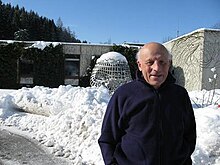Pierre Cartier (mathematician)
Appearance

Pierre Émile Cartier (born 10 June 1932) is a French mathematician. An associate of the Bourbaki group and at one time a colleague of Alexander Grothendieck, his interests have ranged over algebraic geometry, representation theory, mathematical physics, and category theory. He was an Invited Speaker at the International Congress of Mathematicians in Nice in 1970.
| This article about a mathematician is a stub. You can help out with Wikiquote by expanding it! |
Quotes
[edit]- Now one final remark on the term spectrum. In physics each type of atom or molecule possesses a characteristic spectrum formed by its emission or absorption lines. Quantum mechanics interprets these as the characteristic values of an operator, the Hamiltonian, acting on a certain Hilbert space. It is thus natural to speak of the discrete spectrum of the Hamiltonian. The emission or absorption bands correspond to a continuous spectrum. In the early 1930s von Neumann succeeded brilliantly in defining the concept of a self-adjoint (unbounded) operator H on a Hilbert space 𝔥 and its spectrums. The contribution of Gelfand in 1940 was in associating a commutative Banach algebra A with the operator H and an isomorphism of A onto C0(S;). From that point on the evolution of the meaning of the word spectrum can be understood. For Grothendieck the spectrum of a commutative ring consists of its prime ideals (as in the case of Dedekind).
- (2001). "A mad day's work: From Grothendieck to Connes and Kontsevich the evolution of concepts of space and symmetry". Bulletin of the American Mathematical Society 38 (4): 389–408. DOI:10.1090/S0273-0979-01-00913-2. (quote from p. 398)
- ... Formal groups. This topic is by far the deepest and most imaginative creation of Dieudonné, realized when Dieudonné was nearing 50, supposedly the term for an active mathematical life. It can be seen as the creation of a differential calculus for groups over a field of characteristic p > 0 (possibly finite). The methods of calculus do not work, and one has to resort to pure algebra. There were a number of forerunners: a version of Taylor’s formula in characteristic p > 0 due to Dieudonn ́e himself, the ideas of Delsarte about convolution operators (as explained in Book IV, chapter 6 of Bourbaki’s Éléments), a definition of the Lie algebra of a Lie group and its enveloping algebra in terms of distributions on the group (by L. Schwartz). But the impetus came from the book by Chevalley, in 1951, about algebraic groups. Chevalley had developed a purely algebraic version of Lie theory, but restricted to fields of characteristic 0. The case of characteristic p > 0 was “terra incognito”.
In a long series of papers, published between 1954 and 1958, later on collected into a book ... Dieudonné explored in depth this new world.- (August 2005)"Jean Dieudonné (1906-1992) mathematician". Report number IHES-M-2005-28: 1–16. (quote from p. 5)
- Let us now consider toposes. ... Unlike schemes, toposes generate geometry without points. In fact, nothing prevents us from proposing an axiomatic framework for geometry in which points, lines, and planes would all be on the same footing. Thus we know axiomatic systems for projective geometry (George Birkhoff) in which the primitive notion is that of a plate (a generalization of lines and planes), and in which the fundamental relationship is that of incidence. In mathematics, we consider a class of partially ordered sets called lattices; each of these corresponds to a distinct geometry. ...
In the geometry of a topological space, the lattice of open sets plays a starring role, while points are relatively minor. But Grothendieck’s originality was to reprise Riemann’s idea that multivalued functions actually live not on open sets of the complex plane, but on spread-out Riemann surfaces. The spread-out Riemann surfaces project down to each other and thus form the objects of a category. However, a lattice is a special case of a category, since it includes at most one transformation between two given objects. Grothendieck thus proposed replacing the lattice of open sets with the category of spread-out open sets. When adapted to algebraic geometry, this idea solves a fundamental difficulty, since there is no implicit function theorem for algebraic functions. Sheaves can now be considered as special functors on the lattice of open sets (viewed as a category), and can thus be generalized to étale sheaves, which are special functors of the étale topology.
Grothendieck would successfully play many variations on this theme in the context of various problems of geometric construction (for example, the problem of modules for algebraic curves). His greatest success in this regard would be the étale “ℓ-adic” cohomology of schemes, the cohomological theory needed to attack the Weil conjectures.- (2015). "Alexander Grothendieck: A Country Known Only by Name". Notices of the American Mathematical Society 62 (4): 373–382. DOI:10.1090/noti1235. (quote from p. 381)


